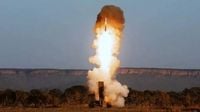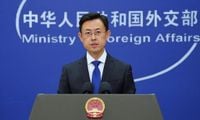For the first time, the United States is set to deploy its advanced Typhon land-based missile system to Japan, marking a significant moment in the evolving military dynamics of the Asia-Pacific region. The deployment, confirmed by both U.S. and Japanese officials, is scheduled to occur during Exercise Resolute Dragon 2025, which will take place from September 11 to September 25. The Typhon system will be stationed at Marine Corps Air Station Iwakuni in Yamaguchi Prefecture, a base that already hosts American F-35B and F-35C stealth fighter jets, according to Newsweek and multiple official statements.
This move, while temporary, is more than just another military exercise. It reflects a broader U.S. strategy to reinforce deterrence capabilities in the Asia-Pacific, particularly as China’s military power continues to grow and regional tensions simmer. The Typhon system, also known as the Mid-Range Capability (MRC), is designed to fire both Tomahawk cruise missiles, with a range of about 1,000 miles, and the Standard Missile-6 (SM-6), which can strike targets up to 290 miles away. These capabilities allow the system to support anti-air, anti-surface, and land-attack roles, providing a complementary edge to existing U.S. and Japanese defense architectures, as highlighted by Zona Militar.
The deployment is part of Exercise Resolute Dragon 25, a bilateral war game aimed at improving interoperability between the U.S. Army and Japan’s Self-Defense Forces. The U.S. Army Pacific emphasized in a statement that the exercise "highlights the importance of interoperability and our shared dedication to peace, security, and a free and open Indo-Pacific." The Third Multi-Domain Task Force, based in Hawaii, will be responsible for operating the Typhon system during the exercise. Each Typhon battery includes an operations center, four launchers, prime movers, and modified trailers, with each launcher capable of carrying and reloading four missiles, as detailed in a U.S. Army briefing.
While the Typhon system’s presence in Japan is set to be temporary—leaving the country after the exercise concludes—its arrival is anything but routine. This marks the third time the Typhon has been deployed in the Western Pacific, following its stationing in the Philippines in April 2024 and a live-fire exercise in Australia in July 2025. Notably, after the drills in the Philippines, the system remained on Philippine territory, a decision that immediately drew objections from China, which is engaged in territorial disputes with the Philippines in the South China Sea, according to Zona Militar.
The upcoming deployment in Japan has already sparked strong reactions from China. On August 29, Chinese Foreign Ministry spokesperson Guo Jiakun stated, "We call upon the US to draw lessons from history and devote more effort and resources to doing the right thing rather than the other way around." Guo underscored that China "always opposes the US deploying the Typhon Mid-Range Capability missile system in Asian countries," citing concerns that such deployments undermine the legitimate security interests of other countries and pose a substantive threat to regional strategic security. The spokesperson further urged, "The US and Japan should respect other countries' security concerns, refrain from the deployment of Typhon, and contribute to regional peace and stability with concrete actions." (Xinhua, Global Times).
Japan’s role in the U.S. strategy is critical. As part of the so-called first island chain—a defensive line across the Western Pacific that includes Taiwan and the Philippines—Japan’s participation in these exercises is seen as a key element in deterring potential Chinese aggression. However, China remains deeply wary of Japan’s military ambitions, especially given the historical context. This year marks the 80th anniversary of the victory in the Chinese People's War of Resistance Against Japanese Aggression and the World Anti-Fascist War. At a press conference, Zhang Xiaogang, spokesperson for China’s Ministry of National Defense, remarked, "At this important historical juncture, Japan should draw profound lessons from history and act with caution in the field of military security."
Chinese military experts have also weighed in on the deployment. Song Zhongping, a well-known analyst, told Global Times that the Typhon system’s cruise missiles, with ranges between 1,500 and 2,000 kilometers, could threaten Southeast Asian countries, including China, especially if future upgrades extend their reach. However, Song noted that the Typhon system is made up of two sets of older weaponry, resulting in "relatively low speed and weak stealth capabilities." He assessed its "actual strike effectiveness is limited, and its overall combat capability is also relatively limited." Still, Song warned that if Japan were to allow the U.S. to maintain a long-term deployment, it "will pose a major threat to Japan and even draw the country into a war."
Japan’s Ministry of Defense, for its part, has stated that the goal of the Typhon deployment is to enhance deterrence, response capacity, and integrated operations. While it remains unclear whether the missile system will be fired during the exercise, the focus is on demonstrating the alliance’s ability to coordinate in multidomain operations and reinforce regional stability. The deployment is being closely watched by neighboring countries, especially given Japan’s postwar pacifist constitution and past commitments to "exclusive defense."
The Typhon system itself represents a leap in U.S. military modernization. Developed by Lockheed Martin and delivered to the U.S. Army since December 2022, it is built to provide a multidomain advantage over adversaries. The U.S. Army is already working with the system’s developer to explore ways to reduce the size of the launcher and transport platform, making it more flexible for future deployments. Interest in acquiring the Typhon system has also been expressed by other countries, notably the Philippines and Germany, as part of their respective modernization plans.
Looking ahead, the deployment of Typhon in Japan is likely to have ripple effects throughout the region. According to Newsweek, China may unveil new weapons capable of striking U.S. military bases in Japan during a military parade on September 3, signaling its own resolve and sending a clear warning to the U.S.-Japan alliance. The coming weeks will be telling, as all eyes remain fixed on the drills and the broader strategic chessboard of the Indo-Pacific.
As the U.S. and Japan move forward with Exercise Resolute Dragon 2025, the temporary presence of the Typhon system underscores the delicate balance between deterrence and provocation in a region where history, strategy, and security are deeply intertwined.

